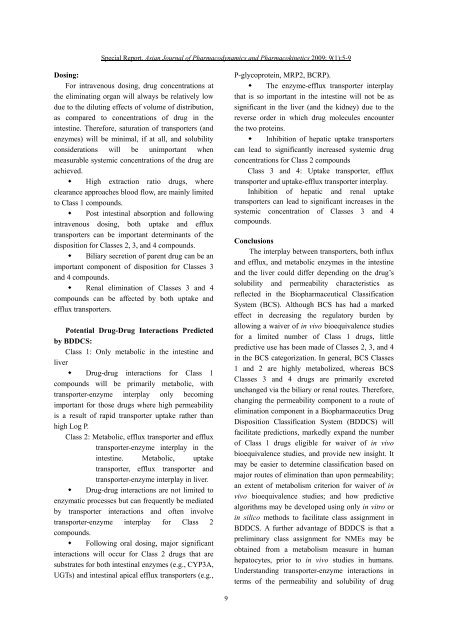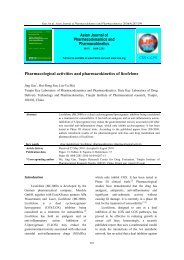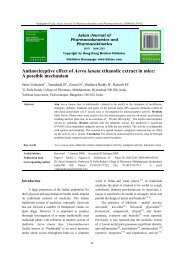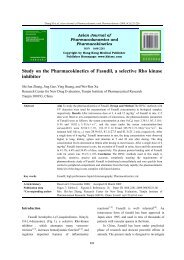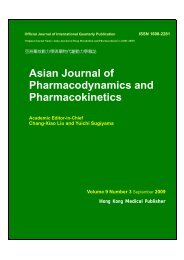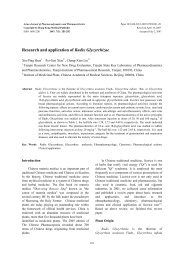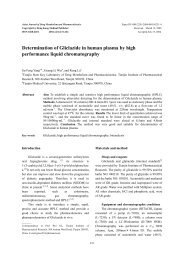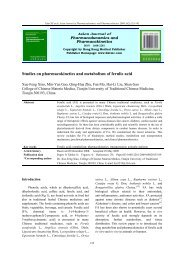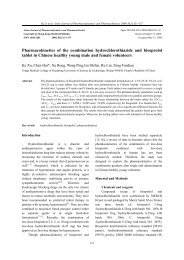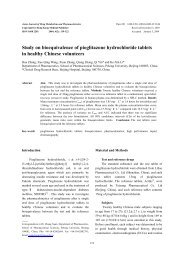Asian Journal of Pharmacodynamics and Pharmacokinetics
Asian Journal of Pharmacodynamics and Pharmacokinetics
Asian Journal of Pharmacodynamics and Pharmacokinetics
You also want an ePaper? Increase the reach of your titles
YUMPU automatically turns print PDFs into web optimized ePapers that Google loves.
Special Report. <strong>Asian</strong> <strong>Journal</strong> <strong>of</strong> <strong>Pharmacodynamics</strong> <strong>and</strong> <strong>Pharmacokinetics</strong> 2009; 9(1):5-9<br />
Dosing:<br />
For intravenous dosing, drug concentrations at<br />
the eliminating organ will always be relatively low<br />
due to the diluting effects <strong>of</strong> volume <strong>of</strong> distribution,<br />
as compared to concentrations <strong>of</strong> drug in the<br />
intestine. Therefore, saturation <strong>of</strong> transporters (<strong>and</strong><br />
enzymes) will be minimal, if at all, <strong>and</strong> solubility<br />
considerations will be unimportant when<br />
measurable systemic concentrations <strong>of</strong> the drug are<br />
achieved.<br />
• High extraction ratio drugs, where<br />
clearance approaches blood flow, are mainly limited<br />
to Class 1 compounds.<br />
• Post intestinal absorption <strong>and</strong> following<br />
intravenous dosing, both uptake <strong>and</strong> efflux<br />
transporters can be important determinants <strong>of</strong> the<br />
disposition for Classes 2, 3, <strong>and</strong> 4 compounds.<br />
• Biliary secretion <strong>of</strong> parent drug can be an<br />
important component <strong>of</strong> disposition for Classes 3<br />
<strong>and</strong> 4 compounds.<br />
• Renal elimination <strong>of</strong> Classes 3 <strong>and</strong> 4<br />
compounds can be affected by both uptake <strong>and</strong><br />
efflux transporters.<br />
Potential Drug-Drug Interactions Predicted<br />
by BDDCS:<br />
Class 1: Only metabolic in the intestine <strong>and</strong><br />
liver<br />
• Drug-drug interactions for Class 1<br />
compounds will be primarily metabolic, with<br />
transporter-enzyme interplay only becoming<br />
important for those drugs where high permeability<br />
is a result <strong>of</strong> rapid transporter uptake rather than<br />
high Log P.<br />
Class 2: Metabolic, efflux transporter <strong>and</strong> efflux<br />
transporter-enzyme interplay in the<br />
intestine. Metabolic, uptake<br />
transporter, efflux transporter <strong>and</strong><br />
transporter-enzyme interplay in liver.<br />
• Drug-drug interactions are not limited to<br />
enzymatic processes but can frequently be mediated<br />
by transporter interactions <strong>and</strong> <strong>of</strong>ten involve<br />
transporter-enzyme interplay for Class 2<br />
compounds.<br />
• Following oral dosing, major significant<br />
interactions will occur for Class 2 drugs that are<br />
substrates for both intestinal enzymes (e.g., CYP3A,<br />
UGTs) <strong>and</strong> intestinal apical efflux transporters (e.g.,<br />
P-glycoprotein, MRP2, BCRP).<br />
• The enzyme-efflux transporter interplay<br />
that is so important in the intestine will not be as<br />
significant in the liver (<strong>and</strong> the kidney) due to the<br />
reverse order in which drug molecules encounter<br />
the two proteins.<br />
• Inhibition <strong>of</strong> hepatic uptake transporters<br />
can lead to significantly increased systemic drug<br />
concentrations for Class 2 compounds<br />
Class 3 <strong>and</strong> 4: Uptake transporter, efflux<br />
transporter <strong>and</strong> uptake-efflux transporter interplay.<br />
Inhibition <strong>of</strong> hepatic <strong>and</strong> renal uptake<br />
transporters can lead to significant increases in the<br />
systemic concentration <strong>of</strong> Classes 3 <strong>and</strong> 4<br />
compounds.<br />
Conclusions<br />
The interplay between transporters, both influx<br />
<strong>and</strong> efflux, <strong>and</strong> metabolic enzymes in the intestine<br />
<strong>and</strong> the liver could differ depending on the drug’s<br />
solubility <strong>and</strong> permeability characteristics as<br />
reflected in the Biopharmaceutical Classification<br />
System (BCS). Although BCS has had a marked<br />
effect in decreasing the regulatory burden by<br />
allowing a waiver <strong>of</strong> in vivo bioequivalence studies<br />
for a limited number <strong>of</strong> Class 1 drugs, little<br />
predictive use has been made <strong>of</strong> Classes 2, 3, <strong>and</strong> 4<br />
in the BCS categorization. In general, BCS Classes<br />
1 <strong>and</strong> 2 are highly metabolized, whereas BCS<br />
Classes 3 <strong>and</strong> 4 drugs are primarily excreted<br />
unchanged via the biliary or renal routes. Therefore,<br />
changing the permeability component to a route <strong>of</strong><br />
elimination component in a Biopharmaceutics Drug<br />
Disposition Classification System (BDDCS) will<br />
facilitate predictions, markedly exp<strong>and</strong> the number<br />
<strong>of</strong> Class 1 drugs eligible for waiver <strong>of</strong> in vivo<br />
bioequivalence studies, <strong>and</strong> provide new insight. It<br />
may be easier to determine classification based on<br />
major routes <strong>of</strong> elimination than upon permeability;<br />
an extent <strong>of</strong> metabolism criterion for waiver <strong>of</strong> in<br />
vivo bioequivalence studies; <strong>and</strong> how predictive<br />
algorithms may be developed using only in vitro or<br />
in silico methods to facilitate class assignment in<br />
BDDCS. A further advantage <strong>of</strong> BDDCS is that a<br />
preliminary class assignment for NMEs may be<br />
obtained from a metabolism measure in human<br />
hepatocytes, prior to in vivo studies in humans.<br />
Underst<strong>and</strong>ing transporter-enzyme interactions in<br />
terms <strong>of</strong> the permeability <strong>and</strong> solubility <strong>of</strong> drug<br />
9


